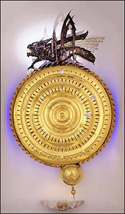29 September 2008
gf laser and the Corpus clock
 One of the world’s most unusual clocks that was manufactured with the help of gf laser was recently unveiled by Professor Stephen Hawking. Dubbed the strangest clock in the world, it features a giant grasshopper and has a series of slits cut into its face which light up to show the time.
One of the world’s most unusual clocks that was manufactured with the help of gf laser was recently unveiled by Professor Stephen Hawking. Dubbed the strangest clock in the world, it features a giant grasshopper and has a series of slits cut into its face which light up to show the time.
The Corpus Clock has been invented and designed by Dr John Taylor for Corpus Christi College Cambridge and is sited on the exterior of the college’s new library building. Dr Taylor, an inventor and horologist, who studied at the College in the 1950’s has overseen the project for the past five years.
The involvement of gf laser with the Corpus Clock project began in 2007 when they were approached to undertake a feasibility study in two areas: Firstly was the laser scoring of the clock face and secondly was the 5 axis laser cutting of the slits in the clock face. Although the idea to laser score the clock was dropped, gf laser were asked to laser cut the slits.
The first challenge for the team at gf laser was to design a suitable fixture that would hold the clock face whilst cutting took place. The other issue that had to be taken into account, when designing a fixture, was the large diameter of the clock that meant it would be close to the axis limit of the Trumpf TLC Cut 5. Although gf laser often used machined fixtures from a sister company within their group it was decided at this stage to utilise the laser fixturing software that is part of the Tru-Tops 3D laser cutting package. This software automatically designs an interlocked egg-box type fixture based on the shape and form of the 3D workpiece, the sections of the fixture are then laser cut from flat sheets and slotted together. The laser also marks a datum point on the fixture which is then referenced by the machine to ensure cutting accuracy.
Once completed the fixture was then welded and a few adjustments were made to ensure that the clock face fitted snugly onto the fixture – It was crucial that once the laser began cutting the clockface remained in the same position or the slits would not be cut in exactly the right place. As part of the evaluation process the first cut was partially undertaken on a clock face that had been rejected at the explosion forming phase. The test cut would also allow the engineers at Huxley Bertram to make any changes after testing the slits with the lenses that would fit behind each laser cut slit.
After the first test only a few alterations were made and the final go-ahead was given to cut a number of clock faces. The skills of the programming team, laser operators and the repeatability capabilities of the Trumpf TLC Cut 5 meant that the final 5 axis laser cuts were performed without any issues. Although gf laser have been involved in a number of unique projects their involvement with the Corpus Clock remains one of their most testing and unusual projects.
More details and video regarding the Corpus Clock can be seen by accessing the following links:
If you want to see the clock in action follow The Guardian newspaper's link (ed.)
- Contact Information
- Name: Simon Tregillus, gf laser
- Email: simon.tregillus@gflaser.co.uk

